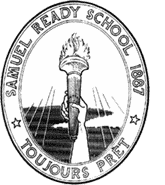For over one hundred years the name of Samuel Ready has been associated with educational opportunities for Maryland girls. From 1887 to 1977, that association was with the Samuel Ready School; from 1977 to the present, with Samuel Ready Scholarships, Inc. Yet, among local philanthropists, he has received only cursory recognition. J. Thomas Scharf in The Chronicles of Baltimore described the fabric of the man as a life "of great industry, frugality, probity, and simplicity of habit." Although these traits were primarily responsible for his substantial legacy, they motivated very little expression of self or his reasons for endowing an institution for orphaned girls.
Samuel Ready was born March 8, 1789, on a farm in the area of southeastern Baltimore County known as Patapsco Neck. When he was old enough, he accompanied his mother to the city markets to help with the sale of farm produce. He came to Baltimore, most likely in 1804, where he was apprenticed to a sailmaking firm. After completing his apprenticeship in 1808, he went to Washington, D.C. to work in the Government's Navy Yard.
When Samuel Ready returned to Baltimore, the city was caught in the War of 1812. His patriotism came naturally. Because of the British blockade, wood was scarce and expensive. He quietly made night-time forays in a sloop to gather loads of wood along the shores to help those who needed it. On August 28, 1814, when the city was threatened, he enlisted in the Sixth Regiment, Maryland Militia. His march to North Point on September 12 may have been more than a military experience, for halfway between the city and the battlefield was the farm where he was born. This experience probably inspired him with some regard for military life and discipline. On September 3, 1817, "Samuel Ready, Gentleman was appointed Lieutenant of Captain Rawlings' Company in the Twenty-Seventh Regiment of the Militia of this State, in the City of Baltimore."
Samuel Ready's successful business career involved two skeins. First, there were his sailmaking and then his lumber businesses from his return to Baltimore until his retirement in 1861. Second, there were his various real estate investments and his civic involvement over the same period. His real estate investments were primarily in the areas of Federal Hill, Inner Harbor, and Fells Point. Records indicate that his petitions to the Mayor and City Council were requests for property improvements, health considerations, and economic development. That Samuel Ready was highly regarded in the affairs of the city is evidenced by the fact that he served on the City Council and as a Judge of Elections.
Samuel Ready's quiet success was reflected in the routines of his bachelor life. He lived simply with a niece and her family on South Hanover Street. In 1861, when he retired from his lumber business, he was seventy-two and in declining health. The city where he had begun his business career at the time of the War of 1812 was again a city in the shadow of conflict. His unpretentious residence was only a few blocks from Federal Hill where Brigadier General Benjamin Butler was encamped.

Whatever the various motivations for what was to be his charitable legacy, Samuel Ready began to express them in substantial form in his retirement. As he was meticulous in business, he was likewise in his plans for the institution he was to endow. After careful legal planning, a charter was prepared. On February 22, 1864, that charter was incorporated by Chapter 102 of the General Assembly of Maryland. The first trustees were named. Nothing more was necessary at that time since Samuel Ready's intention was to have the institution become operative only after his death. The school that was to bear his name opened November 1, 1887.
The remaining years of Samuel Ready's life were ones in which he continued to grow physically feeble and his world smaller. His confinement to his immediate neighborhood and finally to just his home was undoubtedly eased by the devotion of his nieces who cared for him. Although he was limited to his room in the year before his death, his mind remained active and he continued to keep his own books. In the early morning of November 28, 1871, at the age of eighty-two, he died peacefully. He was buried in Green Mount Cemetery. The simple stone at the grave reflects a kind of spartan simplicity that seems to emerge as the quality of the man.

